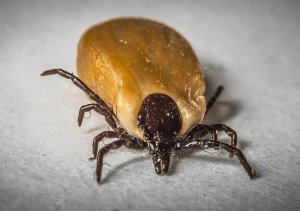It’s tick season right now in beautiful British Columbia. Although ticks aren’t as common in the city, they still pose a threat to our beloved furry friends, especially in well-wooded areas and areas with a high wildlife population. Our four-legged friends are an excellent snack for ticks which means we must do everything we can to take precautions and understand the risks associated with tick bites.
 What are ticks?
What are ticks?
There are more than 40 species of ticks in Canada, and over 20 species found in BC. Ticks are eight legged ectoparasites that feed on blood by digging into the skin. They can do so for anywhere from a few hours to a few days before getting their fill, sometimes spreading diseases, then falling off. A tick will often hide out in tall grass awaiting a blood meal until an unknowing host comes near enough for it to attach onto. They cannot jump or fly, but they are quick to grab onto you when brushed up against.
Стоит ему появиться на ряду, где не хватает какого-либо знака, слот Treasure Island (Остров Сокровищ) без регистрации засчитает призовую комбинацию, использовав «дикий» символ вместо недостающего. Необитаемость острова, экстремальные условия выживания и тематический замысел видео слота отразился на символах игрового автомата. Помимо онлайн чата для консультации с представителем клуба можно использовать электронную почту support@vulkanprestige https://pinupcasino-slots.online/. Во время достижения более высокого статуса, курс становится более выгодным (название статуса – курс обмена поинтов): NEW STAR – 15:1 ; BRONZE STAR – 4:1 ; SILVER STAR – 13:1 ; GOLDEN STAR – 12:1 ; PLATINUM STAR – 11:1 ; BLACK PEARL – 10:1.
Risks
They pose a substantial risk to our pets by carrying diseases. The most common occurring from tick bites are Tick Paralysis, Lyme Disease and Rocky Mountain Spotted Fever. Although there is little risk of disease if the tick is removed quickly and properly after attaching on to you or your dog
1. Tick paralysis is caused by a neurotoxin transmitted to the host (your dog) by a female tick engorged and egg-laden. This generally begins five to seven days after a tick becomes attached if not removed. The first symptoms include numbness in the feet and legs, causing difficulty walking. This progresses quickly to difficulty swallowing and partial paralysis then continues to worsen until death if the tick is not removed. There is usually no pain or fever. Once the tick is removed, symptoms usually will cease rapidly.
2. Lyme disease is cause by bacteria carried from deer ticks. Symptoms might be a solid red rash radiating out from point of bite but they are often mild enough that they are overlooked. If diagnosed early enough, this can be treated with antibiotics so be sure to get your pup into the vet as soon as possible if suspected.
3. Rocky Mountain Spotted Fever is less common in Vancouver but still one of the most serious tick-borne diseases in North America. Symptoms include fever and a spotted rash as the name suggests, but they don’t always present themselves so be sure to consult with a veterinarian as soon as possible.
What you can do to protect your dog from ticks
There are several precautions you can take for both you and your dog when thinking about tick prevention. Some precautions will not apply to your dog, but will help you be aware of the presence of ticks.
- Wear light clothing when hiking so you can easily spot ticks, chances are if you find one on yourself your dog has also been exposed. To help repel ticks you can use commercial insect repellants containing diethyl toluamide (DEET) on yourself.
- Avoid overgrown grass on trails and at home. Keep your lawn cut and other yard items trimmed and clear away any other yard waste to eliminate tick hiding spots.
- Do a full body tick check at the end of the hike, and the day after for both you and your pooch. Ticks grow a substantial amount while feeding, making it easier to find ticks a day or two after your hike. This might be difficult for a dog with darker fur so be sure to do this inadequate lighting and feel for any bumps or hard spots. Ticks are hard bodied and will feel different than your dog’s fur. Ticks often feed in the warmer areas of your dog’s body, around the ears, between their toes, or in their armpits.
- Consult with your veterinarian for tick prevention medications as there are many oral and topical treatments you can give your dog to prevent tick bites.

Removing a tick
If you do find a tick, resist the urge to remove it with your hands. The body is likely to come off, leaving the head or mouth still attached to the skin. Using a pair of tweezers, grasp the head carefully and pull firmly and slowly out of the skin without twisting. Then place the tick in a jar or in alcohol to kill it. Monitor the bite site for a developing rash in the following days, and be sure to check in with your vet if you’re unsure.
There are a number of drastic suggestions on the internet to remove ticks. Things like soap, peppermint oil, fire, or alcohol being applied to the tick, claiming it will cause the tick to remove itself from your skin. Be very wary of these “easy fixes” as they are often unreliable and can cause harm to your dog. If you are not confident removing the tick yourself with tweezers, bring your dog to the vet. They can easily remove the tick and even test it to make sure it is disease free.
Are dog ticks dangerous?
Ticks, though tiny, can consume a lot of your dog’s blood leaving him anaemic.
Ticks are present in almost every dog in small quantities and they are not very dangerous when present in a minimum quantity.
The actual concern is when these ticks exceed in number, excessive ticks can cause irritation, anaemia and serious health issues.
And in worst cases, ticks can pass diseases to your pets including Lyme Disease, Ehrlichiosis, Anaplasmosis and Rocky Mountain fever.
What happens when a dog gets a tick?
Ticks are tiny parasites that penetrate their mouths inside the dog’s skin and suck out the blood.
When your dog gets tick infestation, it can have hazardous consequences.
Look for symptoms like fever, lethargy and anaemia in your dog, these can be a sign of ticks.
Besides anaemia, ticks can lead to joint swelling and arthritis in dogs resulting in permanent lameness.
How do you get rid of dog ticks fast?
Dog ticks are creepy as well as dangerous and need to be gotten rid of, as soon as possible.
After spotting one on your dog, you can get rid of them by the following methods.
You can remove the ticks by pulling them with tweezers. But for greater infestations, tweezers won’t be a suitable option, so in that case, mix water and vinegar in equal quantities and spray it on your dog’s skin.
This solution works wonders in getting rid of ticks, mites, fleas and other dog pests.
How long can a tick live on a dog?
There are a variety of ticks including hard ticks and soft ticks and both have different life spans.
The period of a tick infestation is dependent on the type of tick and also the stage of the lifecycle.
Seed ticks and nymphs can stay alive on a host-dog for about 3 months to 1 year.
While the adult tick can feast on a dog’s blood for a good three year period.
Male ticks usually die after mating while females lay up to 6000 eggs in one go, which can further remain on the body for the next few years.
Read our 5 Tips For Dog Safety.
Written by: Rachelle Biever (CPDT-KA)




